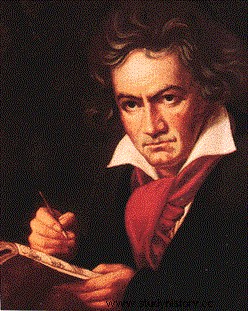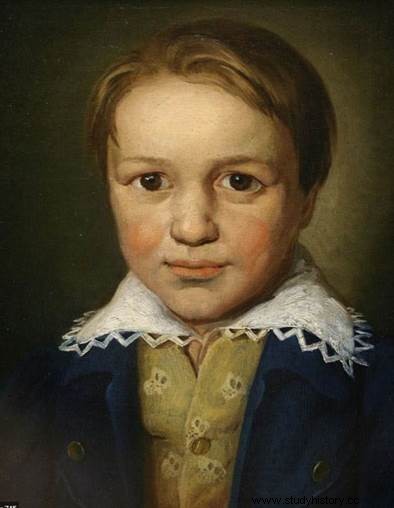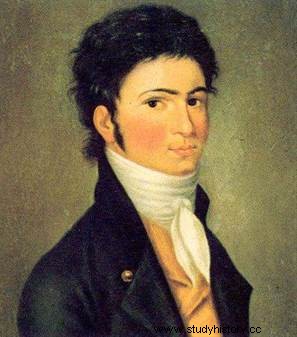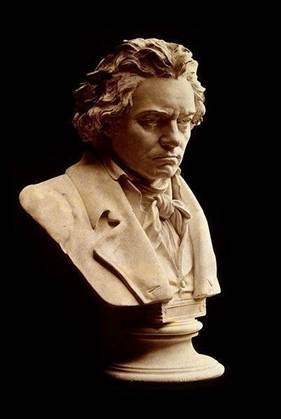 Ludwig van Beethoven (1770-1827) was a German composer and one of the greatest geniuses in the history of Western music. Placed at the junction of two eras with totally opposite tendencies, Beethoven , a contemporary of Haydn and Mozart, expressed classical perfection in his first compositions but at the end of his life, he contributed to the achievement of an art that was to upset all musical habits. His repertoire is rich and varied:he has indeed written piano sonatas, chamber music, masses, an opera, etc. But it is above all his symphonies that have marked the history of music, in particular the famous Ninth Symphony (composed in 1824). Beethoven will inaugurate, in the history of music, the era of romanticism which will undoubtedly be that of German supremacy.
Ludwig van Beethoven (1770-1827) was a German composer and one of the greatest geniuses in the history of Western music. Placed at the junction of two eras with totally opposite tendencies, Beethoven , a contemporary of Haydn and Mozart, expressed classical perfection in his first compositions but at the end of his life, he contributed to the achievement of an art that was to upset all musical habits. His repertoire is rich and varied:he has indeed written piano sonatas, chamber music, masses, an opera, etc. But it is above all his symphonies that have marked the history of music, in particular the famous Ninth Symphony (composed in 1824). Beethoven will inaugurate, in the history of music, the era of romanticism which will undoubtedly be that of German supremacy.
Childhood and early career of Ludwig van Beethoven
Ludwig van Beethoven was born in Bonn on December 15, 1770, from a family originating from Brabant in Belgium. His father, Johan van Beethoven, musician at the court of the Prince Elector of Bonn, had a penchant for alcohol, while his mother, gentle and self-effacing, was like an attentive friend to him. Early on, the child took an interest in music and his father introduced him to the harpsichord and the organ, sometimes late at night, hoping to make him, like Mozart, a little prodigy.
 In 1778, when he was seven and a half years old, Ludwig performed his first public concert in Cologne, during which his father passes him off as a six-year-old child (this fact will distort his knowledge of his real age for a long time). Introduced to composition and the organ with renowned musicians such as Christian Gottlob Neef (who became aware of Ludwig's extraordinary abilities), he also studied ancient and modern philosophers. From the age of eleven, Beethoven entered the court of Cologne as a musician, where he was taught by Christian Gottlob Neefe (1748-1798). While continuing his training, Beethoven gradually integrated into the musical and cultural life of Bonn, having his small circle of students and frequenting the poets and philosophers of the time.
In 1778, when he was seven and a half years old, Ludwig performed his first public concert in Cologne, during which his father passes him off as a six-year-old child (this fact will distort his knowledge of his real age for a long time). Introduced to composition and the organ with renowned musicians such as Christian Gottlob Neef (who became aware of Ludwig's extraordinary abilities), he also studied ancient and modern philosophers. From the age of eleven, Beethoven entered the court of Cologne as a musician, where he was taught by Christian Gottlob Neefe (1748-1798). While continuing his training, Beethoven gradually integrated into the musical and cultural life of Bonn, having his small circle of students and frequenting the poets and philosophers of the time.
Settlement in Vienna:the heroic years
Beetoven's first work appeared in his twelfth year, in 1782:nine variations in C minor for piano. In 1784, recommended by Neff, he was appointed court organist to Prince Maximilian Franz, which enabled him to step out of his father's and family circles and create a new network of relationships. Shortly after, the death of his mother in 1787 and the forfeiture of his alcoholic father placed him before the responsibility of head of the family to his two younger brothers, a role he would assume courageously throughout his life.
With the help of Maximilian he settled in Vienna to perfect his musical education. It was there that he met Mozart, worked with Haydn, studied counterpoint with Labreschaberger and vocal composition with Salieri. He then settled permanently in the Austrian capital and from 1795 acquired a certain notoriety, particularly in aristocratic circles, thanks to his public concerts and his piano improvisations. He then composed a lot for this instrument:sonatas and - marking the quintessence of his style - concertos. His First Symphony was not performed until 1800. The same year, he completed the series of six String Quartets, Op. 18. .
The works composed later (in the first years of the 19th century) reflect Beethoven's perfect assimilation of the Viennese classical style, which he would lead to new horizons. Symphony No. 3 (called Heroic), begun in 1803, premiered privately in 1804 and publicly in 1805, then began for Beethoven a period described as the “heroic decade”. Ending with Symphony No. 8 (1812), this period is, in fact, the most fruitful of his work. It will bring the composer fame and recognition among his contemporaries and will provide him with a certain financial ease.
Feasted by the Viennese aristocracy who recognize his talent (there are loyal friends and protectors including the Archduke Rudolf), his impulsiveness will often lead him to get angry with one or the other, only his talent will excuse his excessive behavior. In 1814, at the Congress of Vienna sovereigns and princes treated him as a “European glory”. Loving his freedom above all, Beethoven was one of the first independent artists who did not belong to any princely chapel.
Portrait of Beethoven
Beethoven was short in stature, bony-faced, broad-brow, short-nosed, protruding jaw, uneven chin, his rapid gait later became abrupt by the fact of his handicap. “He went straight ahead in the silence of his dreams”. His setting, initially neat, will be neglected over time.
He presents himself as the magnificent stature of a man in whom an indomitable will balances a rare power to love and suffer. His multiple and tumultuous loves will bear the “mark” of his absolute and tormented character. Very generous nature, he is passionate about his ideal of justice and charity, freedom and heroism to which he mixes his highest aspirations:Love! love of God and love of men. This double aspiration animates his capital works:“La messe solennelle”, the fifth and the ninth symphonies.
 Impulsive and passionate, he goes through conflicting feelings, going from sadness to joy, from anger to pain, from discouragement to resignation.
Impulsive and passionate, he goes through conflicting feelings, going from sadness to joy, from anger to pain, from discouragement to resignation.
The drama of deafness
As early as 1802, Beethoven expressed his revolt in the face of the tragedy that struck him:deafness insidiously conquered him, a terrible fatality for a musician! But the music calls him back to life, he throws himself into the composition of grandiose works, exceptional piano sonatas (in particular ''the storm'' and the ''chase'' the second and the third symphony, forgetting a his growing handicap.
Around 1805, he composed several symphonies, "the Coriolanus overture", "the pastoral" and the famous "letter for Elise". Taking some young and beautiful pupils, he will sometimes fall in love with it. Having become totally deaf around 1818, Beethoven no longer communicates with the outside world except by means of his Conversation Notebooks (largely preserved, they constitute, with the sketches he left for a large number of works, a valuable source of information).
He will have as protectors his friend Countess Anna Marie Erdödie, Archduke Rudolf, Prince Lobkowitz and Prince Kinski, who pay him an annual pension allowing him to live without constraint in Vienna. Pieces for theatre, masses, and instrumental works for piano, sonatas (including the moonlight sonata) will be created between 1796 and 1822.
Meeting with Goethe and Rossini
It was in July 1822 that Beethoven met Goethe, the two great men admired each other, but did not understand each other, nevertheless the musician would set several poems by Goethe to music and keep sorry for this misunderstanding. He also meets Rossini who triumphs in Vienna, but there too Beethoven's deafness and the language barrier will not allow any constructive exchange between the two composers.
 An illness, contracted in 1826 following a cold will be added to the other ailments from which he suffered throughout throughout his life. Completely deaf and weakened, he died on March 26, 1827, surrounded by his closest friends while a storm raged outside, as a last tribute from nature to the great man he was. During the funeral ceremony, several thousand people accompanied Ludwig van Beethoven to his final resting place. He was buried in Währing Cemetery.
An illness, contracted in 1826 following a cold will be added to the other ailments from which he suffered throughout throughout his life. Completely deaf and weakened, he died on March 26, 1827, surrounded by his closest friends while a storm raged outside, as a last tribute from nature to the great man he was. During the funeral ceremony, several thousand people accompanied Ludwig van Beethoven to his final resting place. He was buried in Währing Cemetery.
The works of Ludwig van Beethoven
Beethoven composed nine symphonies, seven concertos (including five for piano), sixteen string quartets (to which must be added the Grande Fugue, composed in 1825), thirty-two sonatas for piano, ten for piano and violin, five for piano and cello, an opera (Fidelio), two masses, several overtures, incidental music (including that for Egmont by Goethe, in 1809-1810), a ballet (Les Créatures of Prometheus, 1800-1801), numerous series of variations for piano (including the 33 Variations for piano on a theme by Diabelli, 1819-1819) and a large number of lieder.
It is generally said of his work that, breaking the canons of the "classical style" (represented by Haydn and Mozart), it tends entirely towards the exaltation of the self and of personal sensitivity (which until then had no place in music), which earned him the qualifier of “romantic”. In reality, notably through his tribune side and his idealism, Beethoven appears much more like a true son of the French Revolution, and we therefore find no trace in his work of this withdrawal into oneself and this shameless propensity for confession. intimate and direct so characteristic of part of the romantic generation of 1830.
The works of the last period of Beethoven's life are all defined by their exemplary character which will be the unanimous admiration of composers of subsequent generations:in particular the Ninth Symphony and the Missa solemnis (1824), which reflect Beethoven's personal vision of an idealized humanity, and which refer to his cult of the Supreme Being. Beethoven's late style is also evident in the last three Piano Sonatas opus 109 to 111 (1820-1822) and in the last five String Quartets (1824-1826), judged at first to be unplayable and inaudible before being considered to be among the heights of human wit and genius.
Beethoven's posterity
One of Beethoven's legacies is to have contributed to modifying the social image of the composer:once considered as a craftsman working in the service of the Church or under the protective wing from some aristocratic patron—a role that Haydn and Mozart had accepted quite willingly in their early days—the composer now appears (at least in principle) as an independent artist living off his production, having become a sort of secular high priest. As for the musical influence of Beethoven, it is paradoxically both immense - rare, in fact, are (in the 19th century and the beginning of the 20th century) the composers who did not claim to be in one way or another another part of his heritage — and quite limited, due to the strictly inimitable nature of his very personal style.
No artist more than Beethoven directed the art of music towards new destinies. Classic in his first works, he translates in the last his moods, his feelings, giving them a universal scope. Depth of thought, richness of style, color of symphonic development unite for strong, powerful works, which reach greatness and perfection.
We wanted to make Beethoven the ''type'' of the rebel, the artist-prophet, the artist-messiah, but we can simply consider him as a very great musician, a genius and a great soul. Hinge musician, we can say for sure that he was the last of the classics and the first of the romantics.
Bibliography
- Beeethoven biography of Bernard Fauconnier. Folio biographies, 2010.
- Beethoven:Legends and Truths, by Edmond Buchet. Buchet Chastel, 1995.
- Ludwig van Beethoven biography of Jean Massin. Fayard, 1967.
